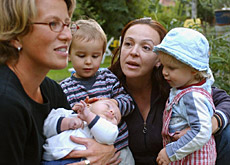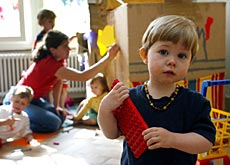Working mothers face childcare shortage

Paid maternity leave in Switzerland finally became a reality on July 1, but who is left holding the baby when mothers return to work?
That’s the dilemma many women face due to the severe shortage of crèche places, especially in the cities.
So while the battle may have been won, the war is still going on: there are currently 120,000 pre-school children who cannot find a place at a crèche or with a childminder.
This means that only 40 per cent of the demand for childcare places is met in Switzerland, according to a new study by the Swiss National Science Foundation.
Its authors discovered that some 30,000 full-time childcare places were available across the country. They predicted the demand would rise by 21 per cent by 2015 and by as much as 27 per cent if more public subsidies were pumped into childcare facilities.
Project leader Susanne Stern told swissinfo that traditional role models could be blamed for the lack of adequate day care.
“Internationally speaking, Switzerland fares badly and that’s because the traditional family unit where the woman stays at home with the children is still common, especially in the German-speaking part of the country,” Stern said.
The heart of the problem lay in “the lack of financial and organisation support from the communes and cantons”. She added that the federal government was a “weak player” because it did not have any competence in this area.
“It is up to the communes and cantons to make a difference and the government to coordinate these efforts,” she said.
Day schools
But even if a working mother manages to find a place for her child at a crèche, the next critical stage is when her offspring goes to school.
Many educational establishments do not cater for children of two working parents, often closing for lunch.
The Swiss Teachers’ Association called last month for day schools to become the norm across the country. This would mean that children could spend the entire day at school, leaving their parents free to put in a full day’s work.
President Beat Zemp said the new day schools would be mostly staffed by non-teachers including social pedagogues and canteen staff. Teachers would also help with homework.
Zemp said the money could come from three sources: federal government, parental contributions and participation from companies.
Think-tank Avenir Suisse says that if parents were required to chip in, they could expect to pay SFr11-70 ($8.50-55) a day for five days a week, depending on their income.
As for firms getting involved, Zemp mentioned the example of a bank in canton Aargau which had committed to spending SFr400,000 on lunches for 100 infants over one year.
Capital example
A Swiss city that is doing fairly well when it comes to providing day schools is the capital Bern.
“By 2007 every school district in Bern will have a day school,” Jürg Haeberli, head of the Youth Office, told swissinfo.
Currently 14 of 18 districts are covered, offering care facilities for children aged between seven and 15. From 8am to 6pm the youngsters stay in the school buildings eating lunch, taking part in activities or getting help with their homework.
The demand for places is high but not unreasonable, says Haeberli. Interested parties can expect a place within six months.
In contrast, the waiting list is two or three years for a place at a public or partially subsidised crèche, which contains 650 children up to age six. The majority are under three years old.
Haeberli explained that waiting times vary, depending on how important it is for a parent to return to work.
He added that there were always places available at private crèches, but these received no public funding and consequently were more expensive.
As for making more publicly subsidised places available, Haeberli said that this was something that would not happen overnight.
“It is difficult to open more crèches,” he said. “Aside from the fact that one needs a cantonal licence and to adhere to rules on the size of the facility, number of children and personnel issues – it is a question of finances.”
swissinfo, Faryal Mirza
From July 1, 2005 all new mothers will be entitled to 14 weeks of maternity leave, paid at 80 per cent of their salary.
Swiss voters agreed to a proposal to introduce statutory paid maternity leave on September 26, 2004.
The Swiss had rejected maternity benefit three times at the ballot box in the past, although the concept was enshrined in the Swiss constitution in 1945.

In compliance with the JTI standards
More: SWI swissinfo.ch certified by the Journalism Trust Initiative










You can find an overview of ongoing debates with our journalists here . Please join us!
If you want to start a conversation about a topic raised in this article or want to report factual errors, email us at english@swissinfo.ch.